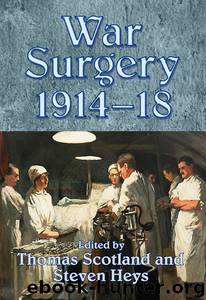War Surgery 1914-18 by Unknown

Author:Unknown
Language: eng
Format: epub
Tags: HISTORY / Military / World War I
ISBN: 4447641
Publisher: Helion & Company, Limited
Published: 2012-06-17T16:00:00+00:00
Provision of X-rays by other combatant nations
At the outset of hostilities in 1914, the British Army was well equipped to deal with the demands of radiology and this, in part at least, was because of experience gained during the Boer War.
Unfortunately, the French Army was not so well prepared in this respect. In fact the French High Command seemed at first indifferent to the need for radiology.16
An important figure in championing the potential importance of X-rays in the clinical management of the wounded was Marie Curie. She was born in Warsaw, Poland, but had to leave Poland to secure an education, and after a period of financial hardship was able to enter the Sorbonne in Paris to study and complete a Masters degree in Physics and Maths. This was quickly followed by a doctorate in 1903. She was the first woman in France to achieve this distinction. Curie’s scientific work was of the highest quality and she obtained two Nobel Prizes, the first for Physics in 1903, and the second for Chemistry in 1911.
At the outbreak of the Great War, Curie was very concerned about the lack of X-ray facilities available to the French Army. There were X-ray facilities in larger hospitals but not in the field hospitals where they were clearly needed. It is reported that in order to give something back to the country of her adoption, she took a personal interest in France’s contribution to this war, even offering to donate her two Nobel Gold Medals and the money she had received from the Nobel Prizes. She undertook a short course in anatomy and radiography, and began training young women including her own daughter, Irene (who also won a Nobel Prize for Chemistry), to be radiographers. Using her position as the pre-eminent French scientist, she begged and borrowed money and cars from her well-off friends and then persuaded car-body shops to turn them into X-ray vans! For the actual X-ray equipment, she went around hospitals and private clinics, wherever X-ray machines were under-used, and somehow obtained them to equip the vans for use in the war.
Beginning in 1914, she sent out over 20 mobile units and permanent units equipped with trained technicians to take X-rays to provide an X-ray service for wounded French soldiers. The first van was staffed by herself and her daughter. Probably the presence of these brave women also helped the morale of the soldiers. The vans were called petite Curies by the combatants. Madame Curie also helped increase X-ray facilities in the base hospitals when they began receive the wounded from the forward areas. She opened, and ran, a training school for X-ray workers from the United States, possibly in her spare time. Over two hundred individuals qualified from her academy17 and consequently by the end of the war, the French medical service had an X-ray division comparable with that of other combatant nations.
Download
This site does not store any files on its server. We only index and link to content provided by other sites. Please contact the content providers to delete copyright contents if any and email us, we'll remove relevant links or contents immediately.
Call Me by Your Name by André Aciman(20378)
Ready Player One by Cline Ernest(14531)
How to Be a Bawse: A Guide to Conquering Life by Lilly Singh(7394)
Wiseguy by Nicholas Pileggi(5674)
The Kite Runner by Khaled Hosseini(5086)
On Writing A Memoir of the Craft by Stephen King(4864)
Audition by Ryu Murakami(4851)
The Crown by Robert Lacey(4731)
Call me by your name by Andre Aciman(4623)
Gerald's Game by Stephen King(4584)
Harry Potter and the Cursed Child: The Journey by Harry Potter Theatrical Productions(4442)
Dialogue by Robert McKee(4326)
The Perils of Being Moderately Famous by Soha Ali Khan(4171)
Dynamic Alignment Through Imagery by Eric Franklin(4119)
Apollo 8 by Jeffrey Kluger(3638)
Seriously... I'm Kidding by Ellen DeGeneres(3577)
The Inner Game of Tennis by W. Timothy Gallwey(3575)
How to be Champion: My Autobiography by Sarah Millican(3557)
Darker by E L James(3480)
